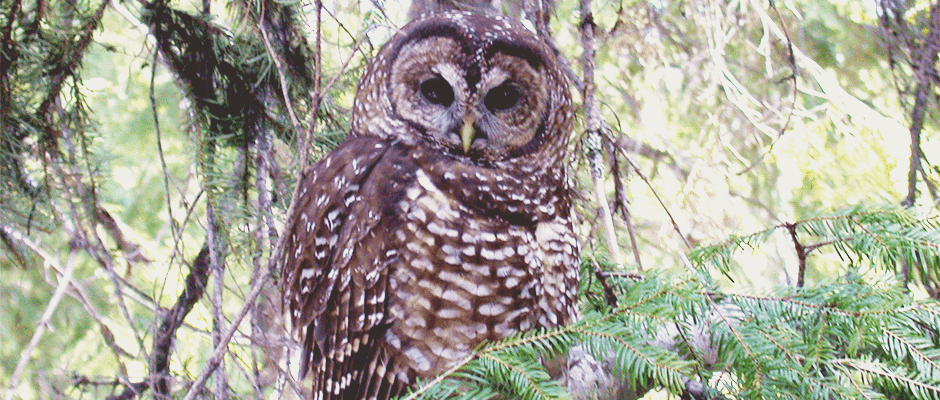Share this article
Barred Owls Intensify Northern Spotted Owl Decline
Populations of federally threatened northern spotted owls (Strix occidentalis caurina), a subspecies native to the western United States, continue to dwindle.
The reason? Competition with the barred owl (Strix varia) — a highly adaptable species that has expanded its range westward from the eastern United States and Canada, according to a study led by Katie Dugger, assistant unit leader at the USGS Oregon Cooperative Fish and Wildlife Research Unit and an associate professor at Oregon State University. The study was recently published in The Condor: Ornithological Applications.
“In our most recent analysis, we got better data on barred owls in particular,” said Eric Forsman, a coauthor in the study who is a retired U.S. Forest Service Research biologist and member of The Wildlife Society. Dugger, Forsman, and their colleagues examined the most recent spotted owl population data from 11 long-term demography study areas in California, Oregon and Washington State. They used mark-recapture models and occupancy models to examine relationships between trends in the owl population and variables such as the amount of old forest cover, climate conditions and the presence of competitors such as barred owls. “Barred owls now outnumber spotted owls on some of our study areas and in some areas, spotted owls are just about gone,” Forsman said.
Barred owls originally occurred in the eastern U.S. and eastern Canada. They began to expand westward sometime in the late 1800s or early 1900s and showed up in Washington State and Oregon in the 1960s and 70s. One hypothesis for this range expansion is that fire exclusion by European settlers allowed forest riparian corridors to become more extensive in the Great Plains region and these areas served as a stepping stone for barred owls to move westward, Forsman said. While researchers didn’t know for sure that barred owls would be a problem when they first began sharing spotted owl habitat, “it now appears that it is a catastrophe for spotted owls,” he said.
Barred owls, a species just slightly larger in size than spotted owls, appear to compete with them for habitat and other resources. For example, barred owls can occur at densities that are four to five times higher than spotted owls and they have a very broad diet that includes many of the same species that are important to spotted owls, including flying squirrels, woodrats, and tree voles, Forsman said. Barred owls also have larger broods and breed more frequently than spotted owls, allowing them to easily outnumber northern spotted owls.
Limited Management Options
Barred owls are taking over to the extent that, on some study areas, the biologists who monitor spotted owls are having a difficult time finding any spotted owls. This is especially true in Washington State, where barred owls have been present the longest.
However, the conservation options appear to be limited. “If you look at the data right now, the outlook is pessimistic,” Forsman said. “As for a solution, we’re not sure. Agencies such as the Forest Service, the BLM and Fish and Wildlife Service are working on it.”
One potential measure is to remove barred owls from certain areas. In fact, researchers completed a small scale removal of barred owls in 2013 in the Green Diamond study area in California by shooting them and found that northern spotted owls began to recover in the removal area. “It’s not yet clear how effective that approach will be in federal lands or remote areas,” Forsman said. Further, this approach is controversial since not everyone agrees that shooting barred owls is a good idea.
Forsman suggested that other possible approaches are to continue with the status quo or increase habitat protection for the northern spotted owl and let the two species work it out. “This is where I fall in this whole debate,” Forsman said. “I can’t see us shooting barred owls forever. But that decision is up to the management agencies, not me.”
Header Image: A federally threatened northern spotted owl sits in a tree. Image Credit: Shane Jeffries, USFS, licensed by cc 2.0








